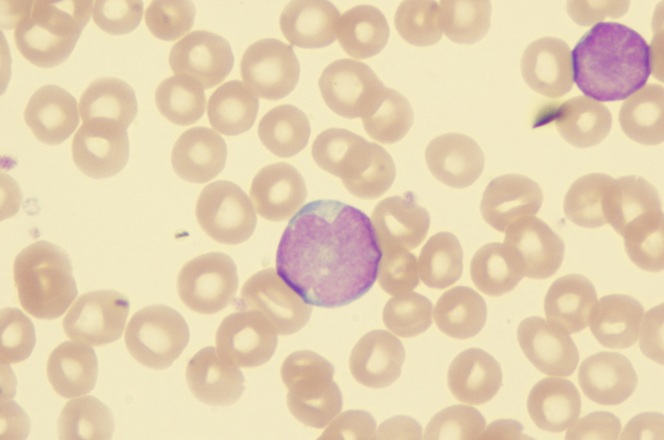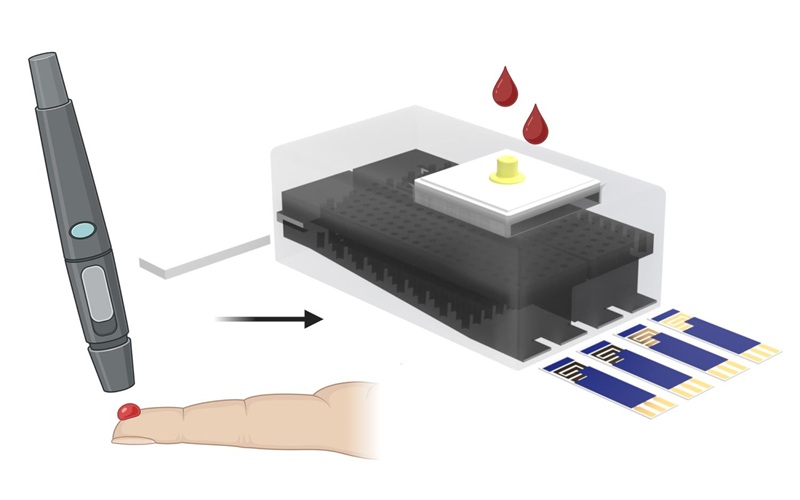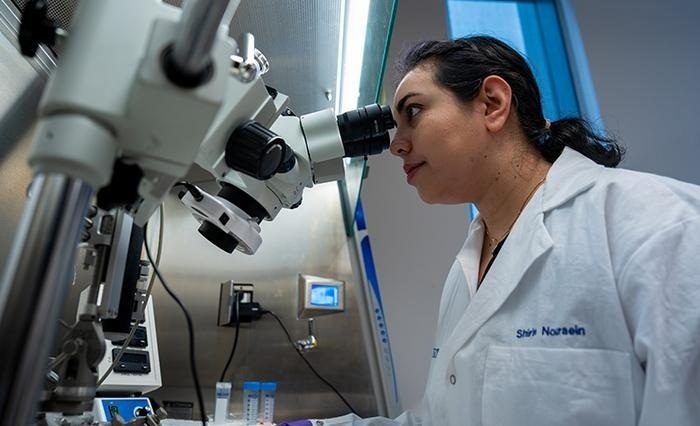Glucocorticoid Receptor Suppresses Tumor Formation by Ensuring Accurate Chromosome Segregation During Mitosis
|
By LabMedica International staff writers Posted on 20 Apr 2015 |

Image: Electrophoretic data confirmed disruption of mitosis in cells lacking GR (Photo courtesy of the University of Manchester).
A team of British molecular biologists has defined the mechanism by which glucocorticoid receptor (GR) regulates the process of mitosis to prevent errors in cell division that could lead to tumor formation.
GR is a member of the nuclear receptor superfamily, which controls programs regulating cell proliferation, differentiation, and apoptosis. GR is expressed in almost every cell in the body and regulates genes controlling development, metabolism, and immune response. As the receptor gene is expressed in several forms, it has many different effects in various parts of the body. Unbound receptor resides in the cytosol of the cell. Binding of GR to glucocorticoids triggers its primary mechanism of action, which is the regulation of gene transcription. After the receptor is bound to glucocorticoid, the receptor-glucorticoid complex up-regulates the expression of anti-inflammatory proteins in the nucleus or represses the expression of pro-inflammatory proteins in the cytosol (by preventing the translocation of other transcription factors from the cytosol into the nucleus).
Investigators at the University of Manchester (United Kingdom) identified an additional role for GR related to regulation of cell division. They discovered that specifically modified GR species accumulated at the mitotic spindle during mitosis in a distribution that overlapped with enzymes of the Aurora kinase family. They found that Aurora A was required to mediate mitosis-driven GR phosphorylation, but not recruitment of GR to the spindle. GR was necessary for mitotic progression, with increased time to complete mitosis, frequency of mitotic aberrations, and death in mitosis observed following GR knockdown. Complementation studies revealed an essential role for the GR ligand-binding domain, but no clear requirement for ligand binding in regulating chromosome segregation.
GR haploinsufficient mice (animals with only a single functional copy of the GR gene that did not produce enough of the gene product to bring about the wild-type condition) had an increased incidence of tumor formation, and these tumors were further depleted for GR, implying additional GR loss as a consequence of cell transformation. Reduced GR expression was identified in a panel of human liver, lung, prostate, colon, and breast cancers.
The unexpected role for the GR in promoting accurate chromosome segregation during mitosis marked GR as an authentic tumor suppressor gene. "Cancer is caused by cell division going wrong, but no one has previously looked at the role GR has to play in this process," said senior author Dr. David Ray, professor of human development at the University of Manchester. "It is now clear that it is vital."
The study was published in the April 6, 2015, online edition of the journal Proceedings of the National Academy of Sciences of the United States of America (PNAS).
Related Links:
University of Manchester
GR is a member of the nuclear receptor superfamily, which controls programs regulating cell proliferation, differentiation, and apoptosis. GR is expressed in almost every cell in the body and regulates genes controlling development, metabolism, and immune response. As the receptor gene is expressed in several forms, it has many different effects in various parts of the body. Unbound receptor resides in the cytosol of the cell. Binding of GR to glucocorticoids triggers its primary mechanism of action, which is the regulation of gene transcription. After the receptor is bound to glucocorticoid, the receptor-glucorticoid complex up-regulates the expression of anti-inflammatory proteins in the nucleus or represses the expression of pro-inflammatory proteins in the cytosol (by preventing the translocation of other transcription factors from the cytosol into the nucleus).
Investigators at the University of Manchester (United Kingdom) identified an additional role for GR related to regulation of cell division. They discovered that specifically modified GR species accumulated at the mitotic spindle during mitosis in a distribution that overlapped with enzymes of the Aurora kinase family. They found that Aurora A was required to mediate mitosis-driven GR phosphorylation, but not recruitment of GR to the spindle. GR was necessary for mitotic progression, with increased time to complete mitosis, frequency of mitotic aberrations, and death in mitosis observed following GR knockdown. Complementation studies revealed an essential role for the GR ligand-binding domain, but no clear requirement for ligand binding in regulating chromosome segregation.
GR haploinsufficient mice (animals with only a single functional copy of the GR gene that did not produce enough of the gene product to bring about the wild-type condition) had an increased incidence of tumor formation, and these tumors were further depleted for GR, implying additional GR loss as a consequence of cell transformation. Reduced GR expression was identified in a panel of human liver, lung, prostate, colon, and breast cancers.
The unexpected role for the GR in promoting accurate chromosome segregation during mitosis marked GR as an authentic tumor suppressor gene. "Cancer is caused by cell division going wrong, but no one has previously looked at the role GR has to play in this process," said senior author Dr. David Ray, professor of human development at the University of Manchester. "It is now clear that it is vital."
The study was published in the April 6, 2015, online edition of the journal Proceedings of the National Academy of Sciences of the United States of America (PNAS).
Related Links:
University of Manchester
Latest BioResearch News
- Genome Analysis Predicts Likelihood of Neurodisability in Oxygen-Deprived Newborns
- Gene Panel Predicts Disease Progession for Patients with B-cell Lymphoma
- New Method Simplifies Preparation of Tumor Genomic DNA Libraries
- New Tool Developed for Diagnosis of Chronic HBV Infection
- Panel of Genetic Loci Accurately Predicts Risk of Developing Gout
- Disrupted TGFB Signaling Linked to Increased Cancer-Related Bacteria
- Gene Fusion Protein Proposed as Prostate Cancer Biomarker
- NIV Test to Diagnose and Monitor Vascular Complications in Diabetes
- Semen Exosome MicroRNA Proves Biomarker for Prostate Cancer
- Genetic Loci Link Plasma Lipid Levels to CVD Risk
- Newly Identified Gene Network Aids in Early Diagnosis of Autism Spectrum Disorder
- Link Confirmed between Living in Poverty and Developing Diseases
- Genomic Study Identifies Kidney Disease Loci in Type I Diabetes Patients
- Liquid Biopsy More Effective for Analyzing Tumor Drug Resistance Mutations
- New Liquid Biopsy Assay Reveals Host-Pathogen Interactions
- Method Developed for Enriching Trophoblast Population in Samples
Channels
Clinical Chemistry
view channel
Chemical Imaging Probe Could Track and Treat Prostate Cancer
Prostate cancer remains a leading cause of illness and death among men, with many patients eventually developing resistance to standard hormone-blocking therapies. These drugs often lose effectiveness... Read more
Mismatch Between Two Common Kidney Function Tests Indicates Serious Health Problems
Creatinine has long been the standard for measuring kidney filtration, while cystatin C — a protein produced by all human cells — has been recommended as a complementary marker because it is influenced... Read moreMolecular Diagnostics
view channel
Genetic Marker to Help Children with T-Cell Leukemia Avoid Unnecessary Chemotherapy
About 400 children in the UK are diagnosed with acute lymphoblastic leukemia (ALL) each year, with roughly 15% presenting with a more aggressive T-ALL subtype. While the standard approach is a four-week... Read more
Four-Gene Blood Test Rules Out Bacterial Lung Infection
Lower respiratory tract infections (LRTIs) are among the most common reasons for antibiotic prescriptions, yet distinguishing bacterial infections from viral ones remains notoriously difficult.... Read more
New PCR Test Improves Diagnostic Accuracy of Bacterial Vaginosis and Candida Vaginitis
Bacterial vaginosis (BV) impacts approximately 25% of women of reproductive age, while up to 75% of women experience candida vaginitis (CV) at least once in their lifetime. Vaginal symptoms are one of... Read moreHematology
view channel
Platelet Activity Blood Test in Middle Age Could Identify Early Alzheimer’s Risk
Early detection of Alzheimer’s disease remains one of the biggest unmet needs in neurology, particularly because the biological changes underlying the disorder begin decades before memory symptoms appear.... Read more
Microvesicles Measurement Could Detect Vascular Injury in Sickle Cell Disease Patients
Assessing disease severity in sickle cell disease (SCD) remains challenging, especially when trying to predict hemolysis, vascular injury, and risk of complications such as vaso-occlusive crises.... Read more
ADLM’s New Coagulation Testing Guidance to Improve Care for Patients on Blood Thinners
Direct oral anticoagulants (DOACs) are one of the most common types of blood thinners. Patients take them to prevent a host of complications that could arise from blood clotting, including stroke, deep... Read moreImmunology
view channel
New Test Distinguishes Vaccine-Induced False Positives from Active HIV Infection
Since HIV was identified in 1983, more than 91 million people have contracted the virus, and over 44 million have died from related causes. Today, nearly 40 million individuals worldwide live with HIV-1,... Read more
Gene Signature Test Predicts Response to Key Breast Cancer Treatment
DK4/6 inhibitors paired with hormone therapy have become a cornerstone treatment for advanced HR+/HER2– breast cancer, slowing tumor growth by blocking key proteins that drive cell division.... Read more
Chip Captures Cancer Cells from Blood to Help Select Right Breast Cancer Treatment
Ductal carcinoma in situ (DCIS) accounts for about a quarter of all breast cancer cases and generally carries a good prognosis. This non-invasive form of the disease may or may not become life-threatening.... Read moreMicrobiology
view channel
Rapid Diagnostic Test Matches Gold Standard for Sepsis Detection
Sepsis kills 11 million people worldwide every year and generates massive healthcare costs. In the USA and Europe alone, sepsis accounts for USD 100 billion in annual hospitalization expenses.... Read moreRapid POC Tuberculosis Test Provides Results Within 15 Minutes
Tuberculosis remains one of the world’s deadliest infectious diseases, and reducing new cases depends on identifying individuals with latent infection before it progresses. Current diagnostic tools often... Read more
Rapid Assay Identifies Bloodstream Infection Pathogens Directly from Patient Samples
Bloodstream infections in sepsis progress quickly and demand rapid, precise diagnosis. Current blood-culture methods often take one to five days to identify the pathogen, leaving clinicians to treat blindly... Read morePathology
view channelAI Tool Outperforms Doctors in Spotting Blood Cell Abnormalities
Diagnosing blood disorders depends on recognizing subtle abnormalities in cell size, shape, and structure, yet this process is slow, subjective, and requires years of expert training. Even specialists... Read more
AI Tool Rapidly Analyzes Complex Cancer Images for Personalized Treatment
Complex digital biopsy images that typically take an expert pathologist up to 20 minutes to assess can now be analyzed in about one minute using a new artificial intelligence (AI) tool. The technology... Read moreTechnology
view channel
Artificial Intelligence Model Could Accelerate Rare Disease Diagnosis
Identifying which genetic variants actually cause disease remains one of the biggest challenges in genomic medicine. Each person carries tens of thousands of DNA changes, yet only a few meaningfully alter... Read more
AI Saliva Sensor Enables Early Detection of Head and Neck Cancer
Early detection of head and neck cancer remains difficult because the disease produces few or no symptoms in its earliest stages, and lesions often lie deep within the head or neck, where biopsy or endoscopy... Read moreIndustry
view channel
Abbott Acquires Cancer-Screening Company Exact Sciences
Abbott (Abbott Park, IL, USA) has entered into a definitive agreement to acquire Exact Sciences (Madison, WI, USA), enabling it to enter and lead in fast-growing cancer diagnostics segments.... Read more









 Analyzer.jpg)













